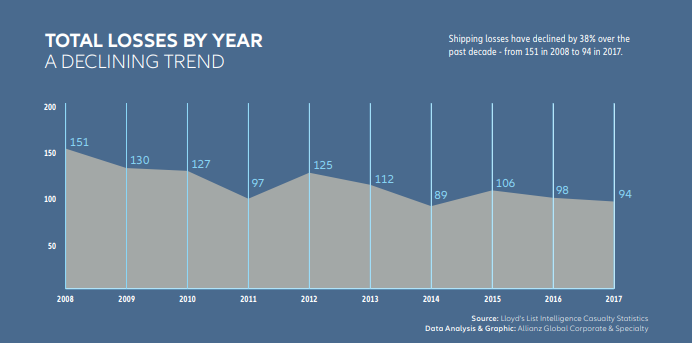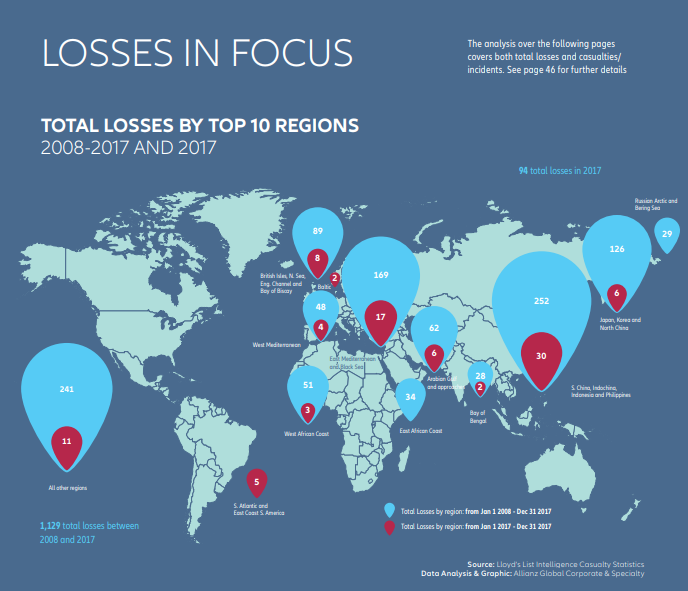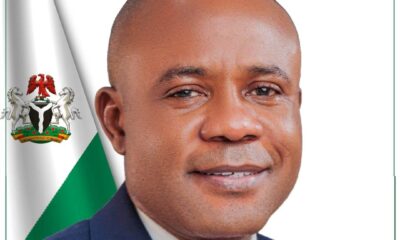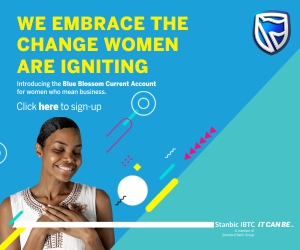GRBusiness
Africa accounts for 32% of piracy incidents globally, says Allianz report


Large shipping losses have declined by more than a third (38%) over the past decade, according to Allianz Global Corporate & Specialty SE’s (AGCS) Safety & Shipping Review 2018, with this downward trend continuing in 2017.
Yet recent events such as the collision of the oil tanker “Sanchi” and the impact of the NotPetya malware on harbor logistics underline that the shipping sector is being tested by a number of traditional and emerging risk challenges.
There was a total of 94 shipping losses reported around the world in 2017, down 4% year-on-year (98) – the second lowest in 10 years after 2014.
Bad weather, such as typhoons in Asia and hurricanes in the US, contributed to the loss of more than 20 vessels, according to the annual review, which analyzes reported shipping losses over 100 gross tons (GT).
“The decline in frequency and severity of total losses over the past year continues the positive trend of the past decade. Insurance claims have been relatively benign, reflecting improved ship design and the positive effects of risk management policy and safety regulation over time,” says Baptiste Ossena, Global Product Leader Hull & Marine Liabilities, AGCS. “However, as the use of new technologies on board vessels grows, we expect to see changes in the maritime loss environment in future. The number of more technical claims will grow – such as cyber incidents or technological defects – in addition to traditional losses, such as collisions or groundings.”
There are multiple new risk exposures for the shipping sector: Ever-larger container ships – longer than the Empire State Building is high – pose fire containment and salvage issues. The changing climate brings new route risks, with fast-changing conditions in Arctic and North Atlantic waters posing new hazards. Environmental scrutiny is growing as the industry seeks to cut emissions, bringing new technical risks and the threat of machinery damage incidents at the same time. Shippers continue to grapple with balancing the benefits and risks of increasing automation on board.
The NotPetya cyber-attack caused cargo delays and congestion at nearly 80 ports, underlining the threat of cyber risks for the sector.
Losses in Africa
The West Africa Coast maritime region is the eighth top location for shipping losses around the world in 2017 with three ships lost – the same level of activity as 12 months earlier. Losses occurred in Senegal, Sierra Leone and Nigeria.
The area is the sixth top loss location over the past decade with 51 ships lost at an average of five a year.
The West Africa Coast is also the tenth top location in the world for shipping incidents with 707 reported incidents in 10 years.
The East Africa Coast maritime region saw two ships lost in 2017 – making it the joint tenth top hotspot overall. Losses occurred in South African and Kenyan waters. The East African Coast is the eight top loss location over the past decade with 34 ships lost at an average of three a year. The Red Sea region has seen 12 ships lost over the past decade.
Piracy levels are down
Piracy activity levels are down year-on-year across Africa with 57 incidents in total during 2017, down 8% (62 incidents in 2016). Africa accounts for 32% of piracy incidents globally (180 in total in 2017), second after South East Asia region.
The Gulf of Guinea remains the regional piracy hot spot with 36 reported incidents in 2017; accounting for 63% of African piracy incidents. However, incidents off the coast of Somalia – which has seen dramatic safety improvements in recent years – increased year-on-year from two incidents in 2016 to nine in 2017.
Drones will have an increasing role in spotting and avoiding hazards at sea. The European Union Naval Force’s anti-piracy naval mission has deployed drones to monitor the coast of Somalia and search for pirate activity.
“The threat of piracy remains, albeit less pronounced than in recent years. “Hijackings and the boarding of vessels continue, tied to inequality and the economic situation in parts of Africa and Asia. It behooves us all to understand that global economic and geopolitical conditions play on the security of shipping,” explains Senior Marine Risk Consultant, at AGCS.
Dangerous seas, Friday 13th and the unluckiest ship
Almost a third of shipping losses in 2017 (30) occurred in the South of China, Indochina, Indonesia and Philippines maritime region, up 25% annually, driven by activity in Vietnamese waters. This area has been the major global loss hotspot for the past decade, leading some media commentators to label it the “new Bermuda Triangle”.
The major loss factors are actually weather – in November 2017, Typhoon Damrey caused six losses – busy seas and lower safety standards on some domestic routes. Outside of Asia, the East Mediterranean and Black Sea region is the second major loss hotspot (17) followed by the British Isles (8). There was also a 29% annual increase in reported shipping incidents in Arctic Circle waters (71), according to AGCS analysis.
Cargo vessels (53) accounted for over half of all vessels lost globally in 2017. Fishing and passenger vessel losses are down year-on-year. Bulk carriers accounted for five of the 10 largest reported total losses by GT.
The most common cause of global losses remains foundering (sinking), with 61 sinkings in 2017. Wrecked/stranded ranks second (13), followed by machinery damage/failure (8).
Analysis shows Friday is the most dangerous day at sea – 175 losses of 1,129 total losses reported have occurred on this day over the past decade. Friday 13th really can be unlucky – three ships were lost on this day in 2012 including Costa Concordia, the largest-ever marine insurance loss.
The unluckiest ship of the past year is a passenger ferry operating in the East Mediterranean and Black Sea region – it was involved in seven accidents in 12 months.
Human error, still a big issue. Data can help.
Despite decades of safety improvements, the shipping industry has no room for complacency. Fatal accidents such as the “Sanchi” oil tanker collision in January 2018 and the loss of the “El Faro” in Hurricane Joaquin in late 2015 persist and human behavior is often a factor. It is estimated that 75% to 96% of shipping accidents involve human error[1].
It is also behind 75% of 15,000 marine liability insurance industry claims analyzed by AGCS – costing $1.6bn[2].
“Human error continues to be a major driver of incidents,” says Captain Rahul Khanna, Global Head of Marine Risk Consulting, AGCS. “Inadequate shore-side support and commercial pressures have an important role to play in maritime safety and risk exposure. Tight schedules can have a detrimental impact on safety culture and decision-making.”
Better use of data and analytics could help. The shipping industry produces a lot of data but could utilize it better, producing real-time findings and alerts, Khanna believes.
“By analyzing data 24/7 we can gain new insights from crew behavior and near-misses that can identify trends. The shipping industry has learned from losses in the past but predictive analysis could be the difference between a safe voyage and a disaster.”
Shippers get serious about cyber threat, as penalties increase
Cyber incidents like the global NotPetya malware event have been a wake-up call for the shipping sector. Many operators previously thought themselves isolated from this threat. “As technology on board increases, so do the potential risks,” says Khanna. At the same time, new European Union laws such as the Network and Information Security Directive (NIS), which requires large ports and maritime transport services to report any cyber incidents and brings financial penalties, will exacerbate the fall-out from any future failure – malicious or accidental.
“The current lack of incident reporting masks the true picture when it comes to cyber risk in the marine industry,” says Khanna. “The NIS directive will bring more transparency around the scale of the problem.”
Other risk topics identified in the review include:
Container ship fire struggles continue: Container-carrying capacity has increased by almost 1,500% in 50 years. Today’s “mega-ships” create new risk exposures and there have been a number of fires at sea in recent years. Fire-fighting capabilities have not necessarily kept pace with increasing vessel sizes.
Climate change brings new route risks: Climate change is impacting ice hazards for shipping, freeing up new trade routes in some areas, while increasing the risk of ice in others – over 1,000 icebergs drifted into North Atlantic shipping lanes last year[3], creating potential collision hazards. Cargo volumes on the Northern Sea Route reached a record high in 2017.
Emissions rules bring problems: Estimates suggest that the shipping sector’s emissions levels are as high as Germany’s, prompting a recent pledge to reduce all emissions by 50% in the long-term, alongside existing commitments to reduce sulphur oxide emissions by 2020.
As the industry looks to technical solutions to achieve these aims, there could be accompanying risk issues with engines and bunkering of biofuels, as well as operator training.
Autonomous shipping and drones: Legal, safety and cyber security issues are likely to limit widespread growth of crewless ships for now. Human error risk will still be present in decision-making algorithms and onshore monitoring bases.
Drones and submersibles have the potential to make a significant contribution to shipping safety and risk management.
Future use could include pollution assessment, cargo tank inspections, monitoring pirates and assessment of the condition of a ship’s hull in a grounding incident.


Source: TechEconomy.ng
-



 GRPolitics4 days ago
GRPolitics4 days agoPeaceful Voting Underway in Central African Republic as 2025 General Elections Commence
-



 Politics3 days ago
Politics3 days agoEnugu Group Lauds Mbah’s Superlative Performance, Pledges 2027 Support
-



 Culture4 days ago
Culture4 days agoAwka Community Elects Fredrick Chinwuba New President General of Awka Development Union of Nigeria (ADUN)
-



 News3 days ago
News3 days agoGOCOP Condoles With Freedom Online Publisher on Son’s Death








